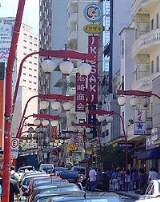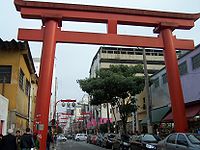
Liberdade
Encyclopedia
Liberdade (libeɾˈdadʒi, Portuguese for "Liberty", "Freedom") is the name of a district in the subprefecture of Sé
, in São Paulo
, Brazil
. It is home to the largest Japanese
community outside of Japan in the world and has been growing since the 1950s.
 Liberdade is São Paulo's own equivalent of Japantown
Liberdade is São Paulo's own equivalent of Japantown
in the USA. Significant populations of Chinese
and Koreans also live in the district of Liberdade. It is served by the São Paulo Metro
.
The entrance to Liberdade is marked by a nine-meter tall red torii
(a Japanese arch that marks the entrance to Shinto
temples) since 1974. This towering structure, situated on Rua Galvão Bueno, is a distinctive representation of the neighborhood. Liberdade was successfully connected to the São Paulo subway network in the 1970s, opening up this area to commerce like never before. Today, thousands of paulistanos (citizens of São Paulo) flock to the public square in Liberdade every Sunday to purchase craft goods at the weekly fair.
In January 2008, in order to celebrate 100 years of Japanese immigration to Brazil, a project to revitalize the quarter was approved by the mayor Gilberto Kassab
. 40% of the restoration were for the visit of the prince Naruhito to São Paulo in June 2008.
The Japanese presence in the neighborhood began in 1912. At this time, Japanese immigrants began to take up residence on the street of Count Sarzedas. This street had a steep slope that gave way to a running stream and swamp area. Basement apartments were numerous and inexpensive, and groups of people or families often lived together in the small rooms. However, the central location of the neighborhood meant immigrants could also be closer to work. As the number of immigrants in the neighborhood grew, so did commercial activity. Soon Japanese owned inns, emporiums, restaurants, shops, and markets were popping up. These new commercial endeavors also become workplaces, which brought more immigrants to the area, and thus the "street of the Japanese" was formed.
Liberdade is a meeting spot for many groups, especially among young people who are interested in Japanese culture. Manga
(Japanese comics) fans, sometimes participating in cosplay
, can be seen in the district almost any day of the week, especially on weekends. The district is also a popular tourist destination. People from all over the world, as well as from Brazil itself, are often seen mixing with the Japanese housewives doing their grocery shopping on Galvao Beuno Street and businessmen looking for low priced Asian food for lunch. Most popular is the street fair that occurs each Saturday and Sunday. Offering tastes of traditional Japanese food and various goods, this famous event attracts so many people from outside of Japan Town that the event is predominantly non-Asian.
Sé (São Paulo)
Sé is the name of the most central borough in the city of São Paulo, in Brazil, divided in eight districts. The name comes from the presence of São Paulo Cathedral in the borough, and it is also the name of the central square...
, in São Paulo
São Paulo
São Paulo is the largest city in Brazil, the largest city in the southern hemisphere and South America, and the world's seventh largest city by population. The metropolis is anchor to the São Paulo metropolitan area, ranked as the second-most populous metropolitan area in the Americas and among...
, Brazil
Brazil
Brazil , officially the Federative Republic of Brazil , is the largest country in South America. It is the world's fifth largest country, both by geographical area and by population with over 192 million people...
. It is home to the largest Japanese
Japanese people
The are an ethnic group originating in the Japanese archipelago and are the predominant ethnic group of Japan. Worldwide, approximately 130 million people are of Japanese descent; of these, approximately 127 million are residents of Japan. People of Japanese ancestry who live in other countries...
community outside of Japan in the world and has been growing since the 1950s.

Japantown
is a common name for official Japanese communities in big cities outside Japan. Alternatively, a Japantown may be called J-town, Little Tokyo, or Nihonmachi , the first two being common names for the Japanese communities in San Francisco and Los Angeles, respectively.-North America:Japantowns were...
in the USA. Significant populations of Chinese
Overseas Chinese
Overseas Chinese are people of Chinese birth or descent who live outside the Greater China Area . People of partial Chinese ancestry living outside the Greater China Area may also consider themselves Overseas Chinese....
and Koreans also live in the district of Liberdade. It is served by the São Paulo Metro
São Paulo Metro
The São Paulo Metro is the principal rapid-transit system in the city of São Paulo and the largest in Brazil. It is also the second largest system in South America and the third largest in Latin America, behind Mexico City and Santiago....
.
The entrance to Liberdade is marked by a nine-meter tall red torii
Torii
A is a traditional Japanese gate most commonly found at the entrance of or within a Shinto shrine, where it symbolically marks the transition from the profane to the sacred...
(a Japanese arch that marks the entrance to Shinto
Shinto
or Shintoism, also kami-no-michi, is the indigenous spirituality of Japan and the Japanese people. It is a set of practices, to be carried out diligently, to establish a connection between present day Japan and its ancient past. Shinto practices were first recorded and codified in the written...
temples) since 1974. This towering structure, situated on Rua Galvão Bueno, is a distinctive representation of the neighborhood. Liberdade was successfully connected to the São Paulo subway network in the 1970s, opening up this area to commerce like never before. Today, thousands of paulistanos (citizens of São Paulo) flock to the public square in Liberdade every Sunday to purchase craft goods at the weekly fair.
In January 2008, in order to celebrate 100 years of Japanese immigration to Brazil, a project to revitalize the quarter was approved by the mayor Gilberto Kassab
Gilberto Kassab
Gilberto Kassab is a Brazilian politician, current mayor of São Paulo. His term ends in 2012. A civil engineer and economist, of Lebanese descent, Kassab took over from José Serra, after Serra decided to run for governor of São Paulo...
. 40% of the restoration were for the visit of the prince Naruhito to São Paulo in June 2008.
The Japanese presence in the neighborhood began in 1912. At this time, Japanese immigrants began to take up residence on the street of Count Sarzedas. This street had a steep slope that gave way to a running stream and swamp area. Basement apartments were numerous and inexpensive, and groups of people or families often lived together in the small rooms. However, the central location of the neighborhood meant immigrants could also be closer to work. As the number of immigrants in the neighborhood grew, so did commercial activity. Soon Japanese owned inns, emporiums, restaurants, shops, and markets were popping up. These new commercial endeavors also become workplaces, which brought more immigrants to the area, and thus the "street of the Japanese" was formed.
Liberdade is a meeting spot for many groups, especially among young people who are interested in Japanese culture. Manga
Manga
Manga is the Japanese word for "comics" and consists of comics and print cartoons . In the West, the term "manga" has been appropriated to refer specifically to comics created in Japan, or by Japanese authors, in the Japanese language and conforming to the style developed in Japan in the late 19th...
(Japanese comics) fans, sometimes participating in cosplay
Cosplay
, short for "costume play", is a type of performance art in which participants don costumes and accessories to represent a specific character or idea. Characters are often drawn from popular fiction in Japan, but recent trends have included American cartoons and science fiction...
, can be seen in the district almost any day of the week, especially on weekends. The district is also a popular tourist destination. People from all over the world, as well as from Brazil itself, are often seen mixing with the Japanese housewives doing their grocery shopping on Galvao Beuno Street and businessmen looking for low priced Asian food for lunch. Most popular is the street fair that occurs each Saturday and Sunday. Offering tastes of traditional Japanese food and various goods, this famous event attracts so many people from outside of Japan Town that the event is predominantly non-Asian.

